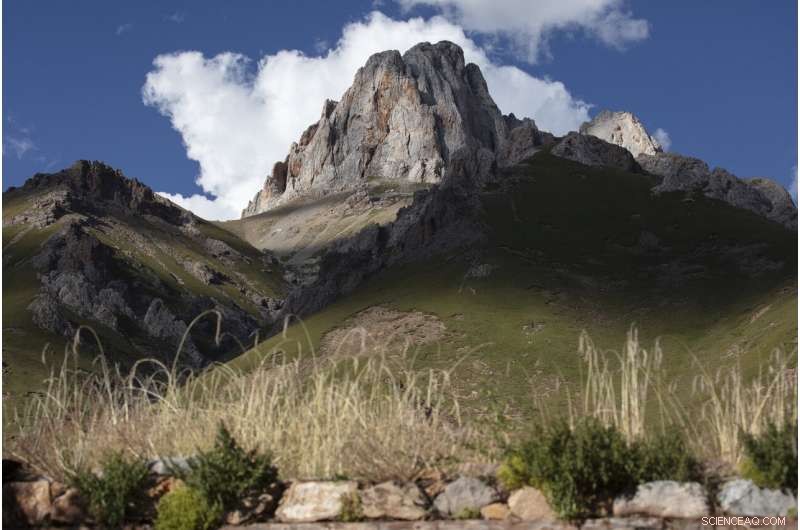
Los picos alcanzan el cielo en Angsai, un área dentro de la región de Sanjiangyuan en la provincia de Qinghai, en el oeste de China, el domingo, 25 de agosto 2019. Rodeado por las cadenas montañosas más altas del mundo, la región conocida desde hace mucho tiempo como "la azotea del mundo" se encuentra ahora en el punto de mira del último impulso de modernización de China. Pero esta vez, el gobierno chino quiere poner límites al crecimiento de la región para implementar su propia versión de uno de los legados más orgullosos de Estados Unidos:un sistema de parques nacionales. (Foto AP / Ng Han Guan)
Hay un auge de la construcción en la meseta tibetana uno de los últimos lugares remotos del mundo. Las montañas coronadas durante mucho tiempo por guirnaldas de banderas de oración ondeando, una bendición tradicional del paisaje, están recién coronadas con extensos cables eléctricos de acero. Por la noche, los letreros iluminados de las gasolineras de Sinopec proyectan un resplandor rojo sobre las carreteras recién construidas.
Rodeado por las cadenas montañosas más altas del mundo, la región conocida desde hace mucho tiempo como "la azotea del mundo" se encuentra ahora en el punto de mira del último impulso de modernización de China, marcado por la multiplicación de rascacielos y la ampliación de las líneas ferroviarias de alta velocidad.
Pero esta vez, Hay una diferencia:el gobierno chino también quiere poner límites al crecimiento de la región para diseñar su propia versión de uno de los legados más orgullosos de Estados Unidos:un sistema de parques nacionales.
En agosto, políticos y científicos de China, Estados Unidos y otros países se reunieron en Xining, capital de la provincia de Qinghai del país, discutir los planes de China para crear un sistema de parques unificado con estándares claros para limitar el desarrollo y proteger los ecosistemas.
La economía del país ha experimentado un auge en los últimos 40 años, pero las prioridades ahora se están expandiendo para incluir la conservación de recursos naturales clave, dice Zhu Chunquan, el representante de China de la Unión Internacional para la Conservación de la Naturaleza, un grupo científico con sede en Suiza.
"Es muy urgente identificar los lugares lo antes posible, los ecosistemas y otras características naturales "para proteger, Dice Zhu.

Una mujer tibetana atiende a un niño en Angsai, un área dentro de la región de Sanjiangyuan en la provincia de Qinghai, en el oeste de China, el domingo, 25 de agosto 2019. Una pregunta clave se cierne sobre el proyecto de parques nacionales del país:¿Puede China unir los objetivos de conservación y turismo? salvaguardando los medios de vida y la cultura de los aproximadamente 128, 000 personas que viven dentro o cerca de los límites del parque, muchos de ellos tibetanos? (Foto AP / Ng Han Guan)
Entre otros objetivos, China tiene como objetivo construir su propio Yellowstone en la meseta tibetana.
Zhu forma parte de un comité asesor que proporciona información sobre el desarrollo del naciente sistema de parques nacionales de China, Se espera que se dé a conocer oficialmente en 2020. Los funcionarios chinos también han visitado los parques nacionales de EE. UU., incluidos Yellowstone y Yosemite, y buscó aportes de diversas organizaciones, incluidos el Paulson Institute y Nature Conservancy, con sede en Chicago.
La ambición de crear un sistema de parques unificado representa "un esfuerzo nuevo y serio para salvaguardar la biodiversidad y el patrimonio natural de China, "Dice Stuart Pimm, ecologista de la Universidad de Duke.
Uno de los primeros parques piloto estará en Qinghai, una vasta región en el oeste de China que linda con el Tíbet y que comparte gran parte de su legado cultural. El área también alberga especies tan emblemáticas y amenazadas como el leopardo de las nieves y el gato montés chino, y abarca las cabeceras de tres de las grandes vías fluviales de Asia:el Yangtze, Ríos Amarillo y Mekong.
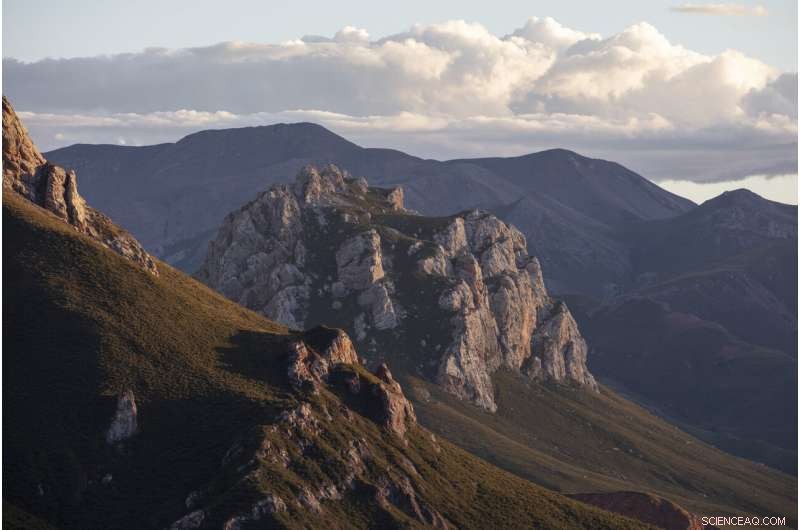
Las nubes se ciernen sobre el paisaje montañoso de Angsai, un área dentro de la región de Sanjiangyuan en la provincia de Qinghai, en el oeste de China, el domingo, 25 de agosto 2019. China tiene como objetivo construir su propio Yellowstone en la meseta tibetana. (Foto AP / Ng Han Guan)
"Esta es una de las regiones más especiales de China, en el mundo, "dice Lu Zhi, un biólogo conservacionista de la Universidad de Pekín que ha trabajado en Qinghai durante dos décadas.
Mientras la construcción continúa a un ritmo frenético en otras partes de la meseta tibetana, el gobierno ya dejó de emitir permisos de minería e hidroeléctricas en esta región.
Pero una pregunta clave se cierne sobre el proyecto:¿Puede China casar los objetivos de conservación y turismo? salvaguardando los medios de vida y la cultura de los aproximadamente 128, 000 personas que viven dentro o cerca de los límites del parque, muchos de ellos tibetanos?
"China tiene una población densa y una larga historia, "Dice Zhu." Una de las características únicas de los parques nacionales de China es que tienen habitantes locales que viven dentro o cerca ".
Yellowstone es ampliamente considerado el primer parque nacional del mundo. Después de su creación en 1872, el gobierno de los Estados Unidos obligó a los nativos americanos que vivían en el área a reubicarse fuera de los límites del parque, de acuerdo con la noción del siglo XIX de que la protección de las áreas silvestres significaba naturaleza separada de las personas. Pero los países que intentan establecer sistemas de parques en el siglo XXI ahora deben considerar la mejor manera de incluir a las poblaciones locales en su planificación.
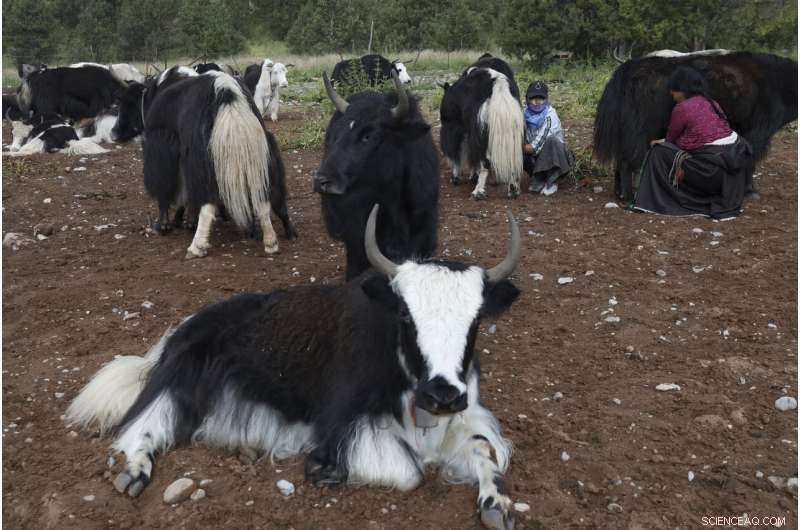
Las mujeres tibetanas ordeñan sus yaks en Angsai, un área dentro de la región de Sanjiangyuan en la provincia de Qinghai, en el oeste de China, el domingo, 25 de agosto 2019. Qinghai es una vasta región del oeste de China que linda con el Tíbet y comparte gran parte de su legado cultural. (Foto AP / Ng Han Guan)
"Descubrir cómo lograr la conservación ecológica y el apoyo a las comunidades al mismo tiempo, ese es el problema más complicado que tienes, "dice Jonathan Jarvis, ex director del Servicio de Parques Nacionales de EE. UU. y ahora profesor de la Universidad de California, Berkeley, que ha recorrido el parque piloto de Qinghai, llamado Sanjiangyuan.
China ha llevado a cabo con anterioridad amplios programas de reasentamiento para despejar tierras para grandes proyectos de infraestructura. como la presa de las Tres Gargantas y el Proyecto de Transferencia de Agua de Sur a Norte. Estos reasentamientos dejaron a muchos agricultores en nuevos hogares sin campos agrícolas adecuados ni acceso a otros medios de vida.
Pero al desarrollar los parques nacionales, el gobierno está dando trabajos relacionados con la conservación a al menos una franja de personas que viven en Sanjiangyuan para que se queden y trabajen en sus tierras. La "Familia Única, El programa One Ranger contrata a una persona por familia por 1800 yuanes al mes (255 dólares) para realizar tareas como recolectar basura y monitorear la caza furtiva o la actividad de pastoreo ilegal.
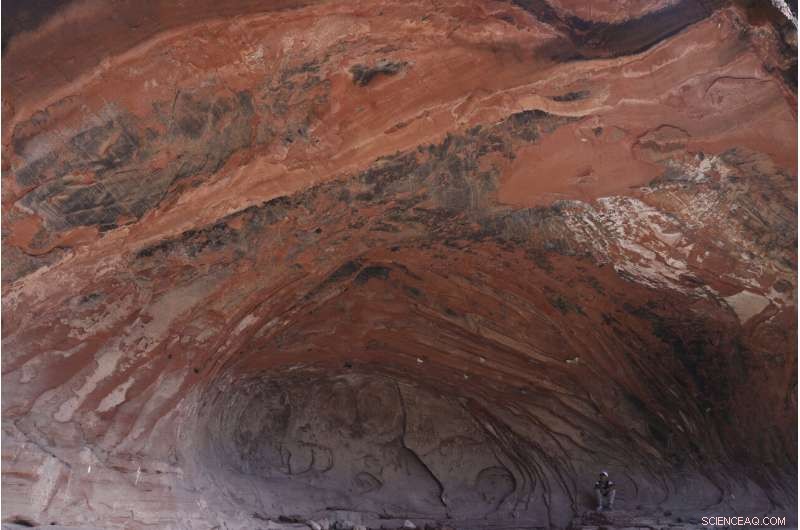
Un joven tibetano se sienta en la base de una formación de cueva natural en Angsai, un área dentro de la región de Sanjiangyuan en la provincia de Qinghai, en el oeste de China, el domingo, 25 de agosto 2019. China has previously undertaken vast resettlement programs to clear land for large infrastructure projects, but in developing the national parks, the government is giving conservation-related jobs to at least a swath of people living in Sanjiangyuan to stay and work on their land. (Foto AP / Ng Han Guan)
It's difficult to interview residents in China's ethnic borderlands like Qinghai, due to restrictions on journalists that make it hard to travel widely or freely in those areas. Regions with large ethnic and religious minorities, including all Tibetan areas, are subject to heightened political and religious controls.
But a few people living in Angsai, a Tibetan village located within the new Qinghai park, were willing to speak, although it's not possible to determine if their experiences are typical.
A-Ta is a Tibetan herder whose income largely comes from raising yaks and collecting caterpillar fungus, a folk medicine taken as a purported aphrodisiac or for respiratory problems. He also leads a team of trash collectors, traveling as much as 34 kilometers (21 miles) a day to comb the hillsides for plastic bottles and other waste as part of the "One Family, One Ranger" program.

A-Ta, at right stands near his father in their home in Angsai, an area inside the Sanjiangyuan region in western China's Qinghai province on Monday, 26 de agosto 2019. A-Ta, a Tibetan herder whose income largely comes from raising yaks and collecting caterpillar fungus, also leads a team of trash collectors traveling as much as 34 kilometers (21 miles) a day to comb the hillsides for plastic bottles and other waste, as part of the "One Family, One Ranger" program. (AP Photo/Ng Han Guan)
"I am living in this land, my living is relying on this land, " él dice, as his sister heats a kettle in their modest home. A poster showing the faces of China's past leaders and current Communist Party general secretary, Xi Jinping, hangs on the wall.
A-Ta says he is grateful for work that allows his family to stay on their land, even as people in other parts of Qinghai have had to leave. His own son is employed leading a relocation program for "a huge population of nomads" in Dzarto, a county in southern Qinghai.
"I love this land very much, " he says. "I always motivate and encourage people to protect the environment and contribute to the conservation work."
Kunchok Jangtse is a Tibetan herder who also earns money cleaning up rubbish through the "One Family, One Ranger" program.
He has an additional volunteer position through the Chinese nonprofit Shanshui—the name means "mountain, water"—installing and maintaining motion-activated camera traps, which help scientists monitor endangered species in Qinghai.
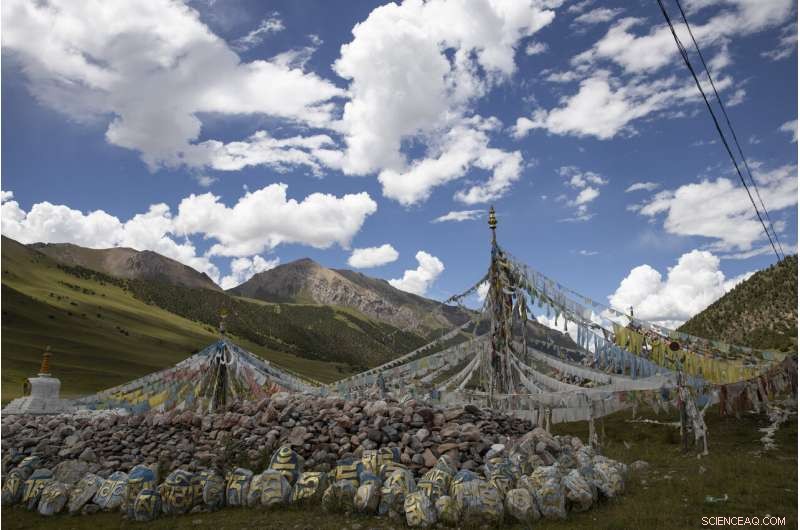
Tibetan prayer flags are seen during a clear day in Angsai, an area inside the Sanjiangyuan region in western China's Qinghai province on Monday, 26 de agosto 2019. Qinghai is a vast region in western China abutting Tibet and shares much of its cultural legacy. (Foto AP / Ng Han Guan)
As he affixes a camera trap to a thin tree trunk, el explica, "The reason why it has to be installed in this location is because this is the main migration route of the majority of wild animals."
Such camera traps have captured rare footage of snow leopards and Chinese mountain cats, including mothers and their cubs playing near a temporary den.
Kunchok Jangtse says the work of protecting the environment, including reporting illegal poaching activity, es importante.
"Our religion is connected with wild animals, because wild animals have a consciousness and can feel love and compassion—therefore, we protect wild-animals, " él dice.
From his main work raising livestock and collecting caterpillar fungus, Kunchok Jangtse says he can make about 20, 000 yuan ($2, 830) a year. He is grateful for the additional income from the ranger program, but mainly hopes his other livelihood won't be impeded—and that he won't eventually be forced to leave.
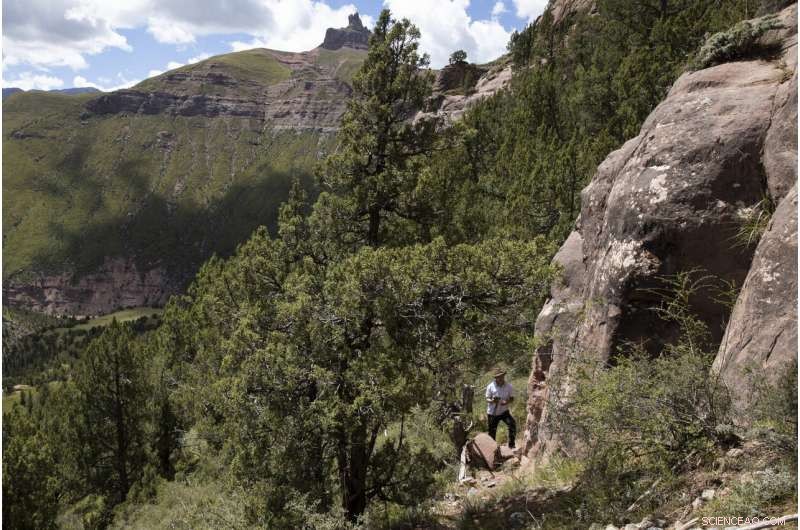
Kunchok Jangtse, a Tibetan herder who also instals and maintains motion-activated cameras, works on a camera in Angsai, an area inside the Sanjiangyuan region in western China's Qinghai province on Tuesday, 27 de agosto 2019. His work helps scientists monitor endangered species. "I'm not a highly educated person, and I am very concerned it may bring many difficulties in my life if I would switch my job and move to another place, " he says. (AP Photo/Ng Han Guan)
"I'm not a highly educated person, and I am very concerned it may bring many difficulties in my life if I would switch my job and move to another place, " él dice.
The question of local people's culture and livelihoods is one of the top concerns that former U.S. National Park Service director Jarvis says China has to wrestle with, along with establishing laws and funding.
"They need a legal framework that defines what a park is, " Jarvis says. "And they need sustainable funding."
The creation of protected areas is not a new idea in China. De hecho, roughly 15% of the country's land already is assigned to a bewildering patchwork of local and regional parks. But many existing reserves are simply parks on paper, run by various agencies without enforceable guidelines.
A diferencia de, the national parks system is being designed from the ground-up to incorporate global best practices and new science.
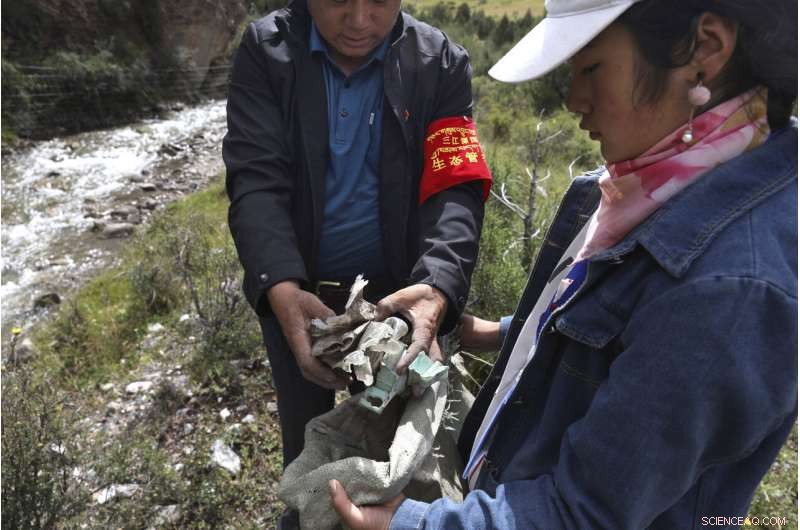
A-Ta, a Tibetan herder whose income largely comes from raising yaks and collecting caterpillar fungus, places refuse in a bag as he leads his team of trash collectors in Angsai, an area inside the Sanjiangyuan region in western China's Qinghai province on Monday, 26 de agosto 2019. His team travels as much as 34 kilometers (21 miles) a day to comb the hillsides for plastic bottles and other waste, as part of the "One Family, One Ranger" program. "I am living in this land, my living is relying on this land, " he says. (AP Photo/Ng Han Guan)
In his office in Beijing, Ouyang Zhiyun, deputy director at the Chinese Academy of Sciences' Research Center for Eco-Environmental Sciences, pores over hundreds of carefully shaded maps of mainland China that denote priority areas for protecting threatened and endangered species, as well as "eco-system services, " like safeguarding water supplies and limiting soil erosion.
The question isn't just how much total land you're protecting, but which lands you're protecting, él nota.
Recientemente, Ouyang was the lead scientist for China's sweeping "national ecosystems assessment, " which used 20, 000 satellite images and 100, 000 field surveys to examine how China's land changed between 2000 and 2010, with some of the findings published in the journal Science in 2016. One resulting statistic:China's urban area increased 28% during that period.
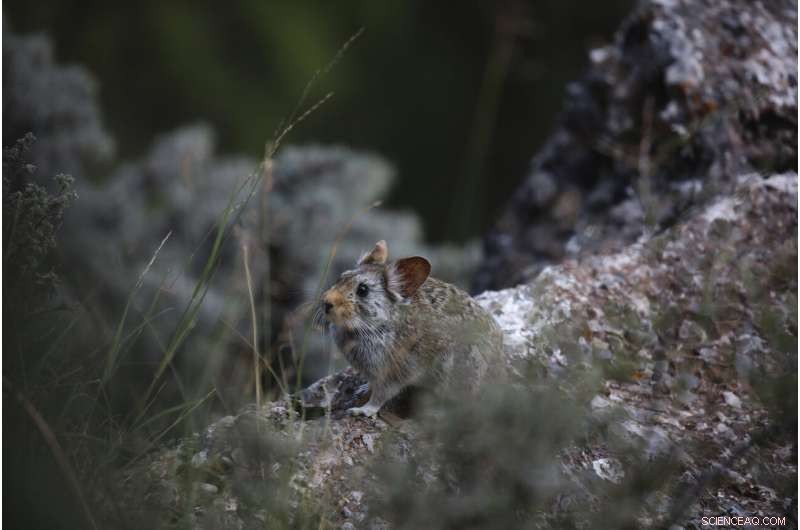
A Glover's Pika surveys its surrounding in Angsai, an area inside the Sanjiangyuan region in western China's Qinghai province on Tuesday, 27 de agosto 2019. (AP Photo/Ng Han Guan)
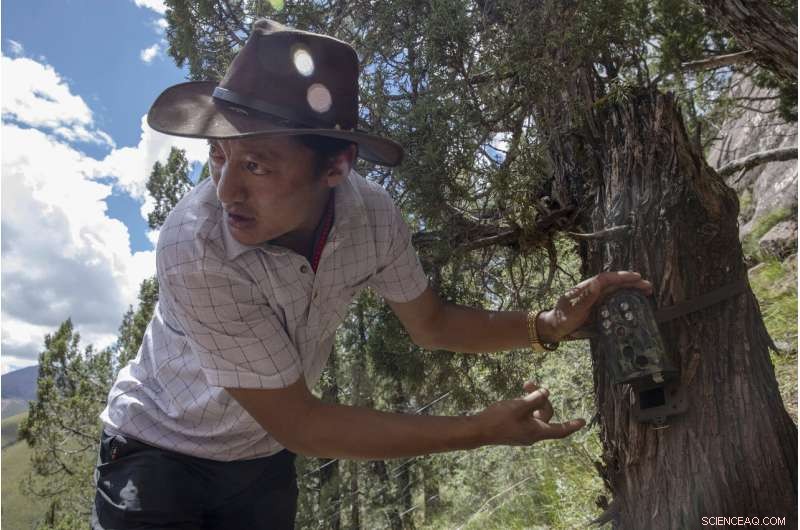
Kunchok Jangtse positions a camera trap in Angsai, an area inside the Sanjiangyuan region in western China's Qinghai province on Tuesday, 27 de agosto 2019. The Tibetan herder also has a job installing and maintaining the motion-activated cameras, which help scientists monitor endangered species in the area. "Our religion is connected with wild animals, because wild animals have a consciousness and can feel love and compassion—therefore, we protect wild-animals, " he says. (AP Photo/Ng Han Guan)
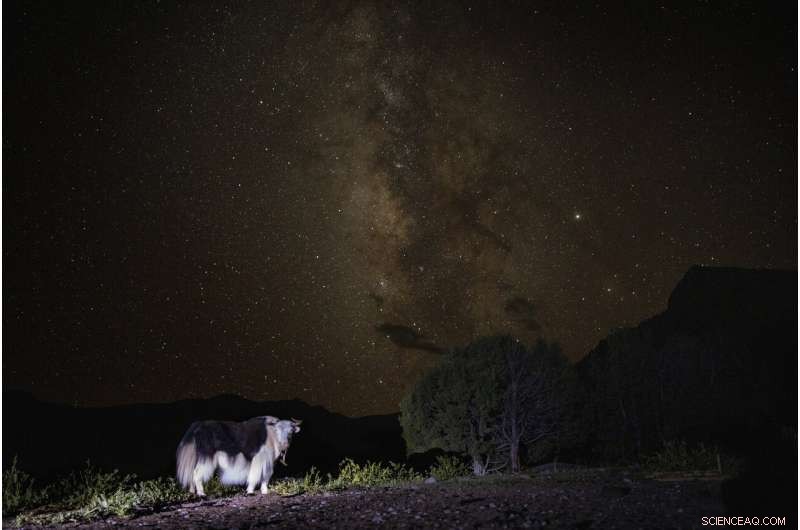
The Milky Way glows behind a yak in Angsai, an area inside the Sanjiangyuan region in western China's Qinghai province on Monday, 26 de agosto 2019. "This is one of the most special regions in China, in the world, " says Lu Zhi, a Peking University conservation biologist who has worked in Qinghai for two decades. (Foto AP / Ng Han Guan)
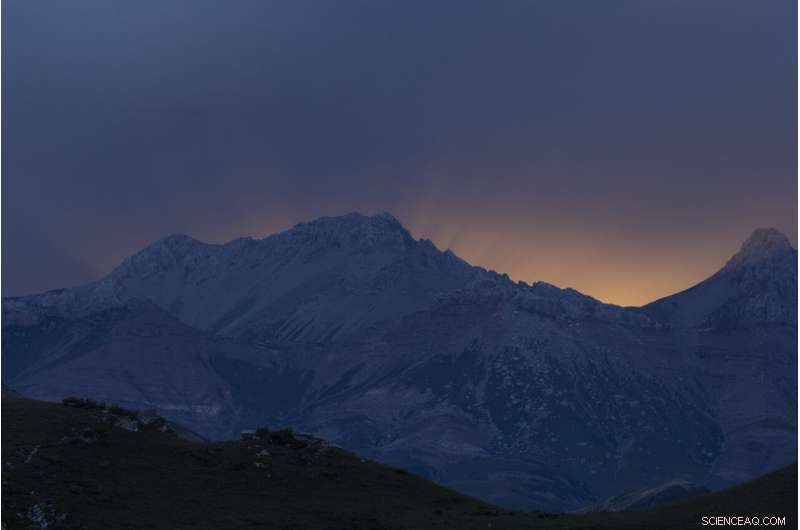
A sunset casts rays of light over the top of a mountain range in Angsai, an area inside the Sanjiangyuan region in western China's Qinghai province on Monday, 26 de agosto 2019. "This is one of the most special regions in China, in the world, " says Lu Zhi, a Peking University conservation biologist who has worked in Qinghai for two decades. (Foto AP / Ng Han Guan)

A bat flies through a narrow crevice in Wuyishan in eastern China's Fujian province on Tuesday, 13 de agosto 2019. (AP Photo/Ng Han Guan)

A monkey bares its teeth at visitors in an animal shelter that is part of tourist site in Wuyishan in eastern China's Fujian province on Friday, 16 de agosto 2019. (AP Photo/Ng Han Guan)
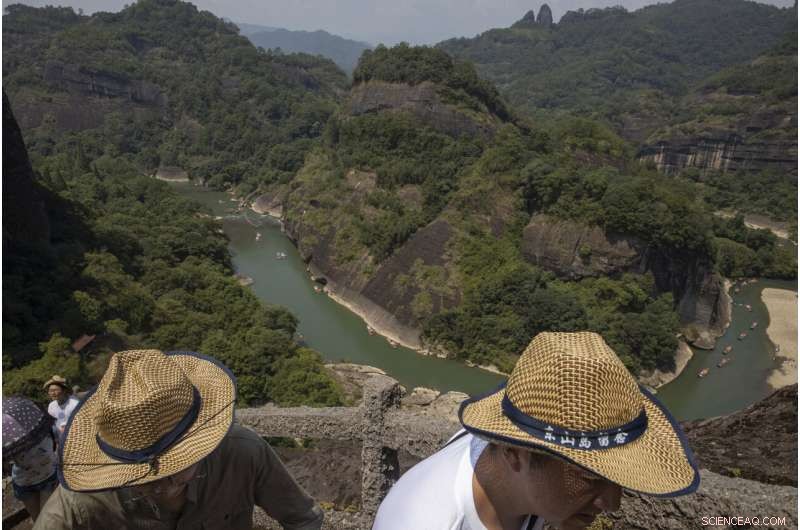
Visitors climb Tianyou peak in Wuyishan in eastern China's Fujian province on Wednesday, Aug. 14, 2019. The ambition to create a unified park system represents "a new and serious effort to safeguard China's biodiversity and natural heritage, " says Duke University ecologist Stuart Pimm. (AP Photo/Ng Han Guan)

Women work on a photo for their tea products on a mountain top in Wuyishan in eastern China's Fujian province on Wednesday, Aug. 14, 2019. Zhu Chunquan, the China representative of the International Union for the Conservation of Nature, a Switzerland-based scientific group, notes that the country's economy has boomed over the past 40 years. But priorities are now expanding to include conserving the country's key natural resources. "It's quite urgent, as soon as possible to identify the places, the ecosystems and other natural features" to protect, Zhu says. (Foto AP / Ng Han Guan)
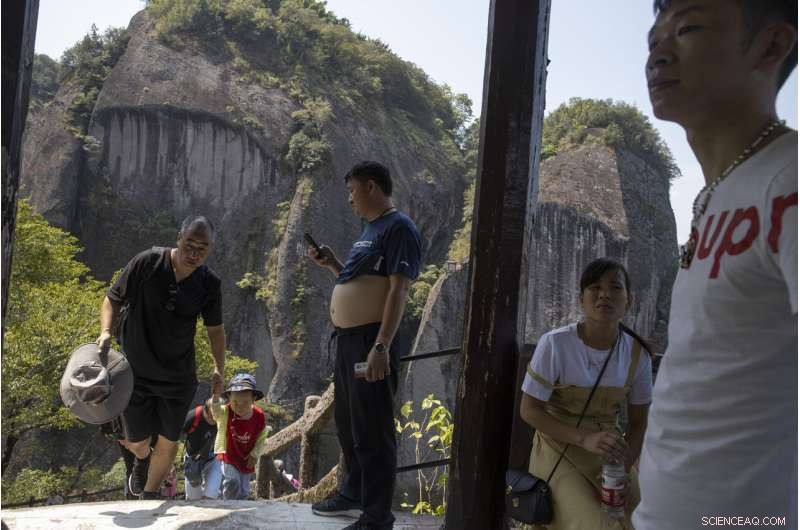
Visitors rest in a pavilion during a climb up Tianyou peak in Wuyishan in eastern China's Fujian province on Wednesday, Aug. 14, 2019. (AP Photo/Ng Han Guan)
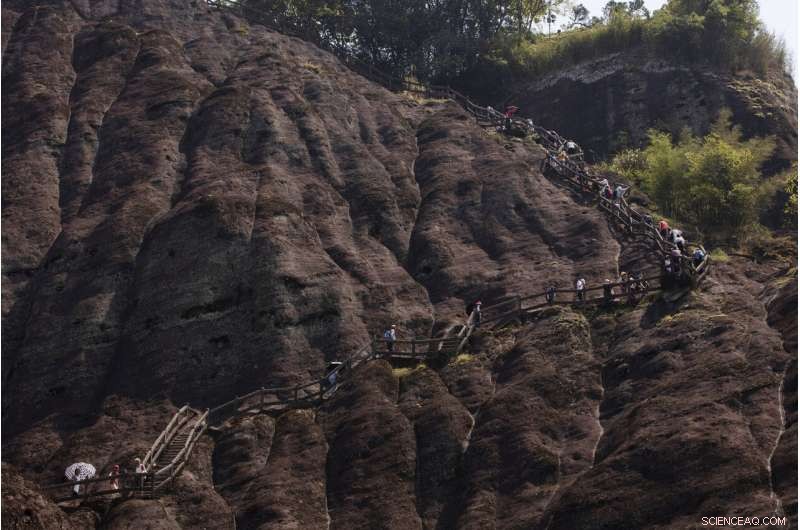
Visitors climb Tianyou peak in Wuyishan in eastern China's Fujian province on Wednesday, Aug. 14, 2019. (AP Photo/Ng Han Guan)
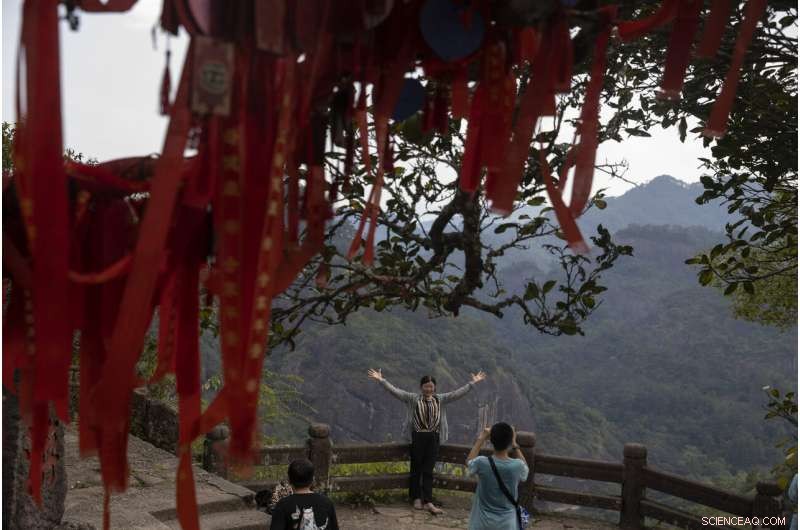
A visitor poses for a photo on Tianyou peak in Wuyishan in eastern China's Fujian province on Wednesday, Aug. 14, 2019. (AP Photo/Ng Han Guan)
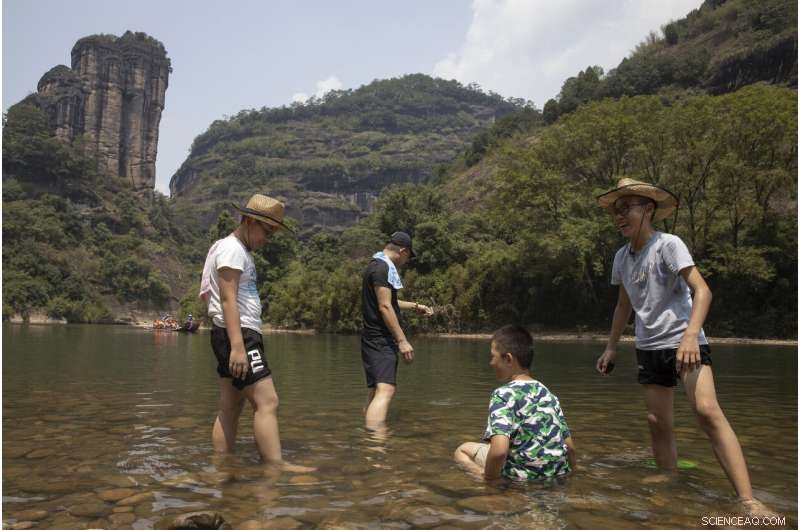
A woman poses for photos near a waterfall in Wuyishan in eastern China's Fujian province on Thursday, 15 de agosto 2019. (AP Photo/Ng Han Guan)

Tourists stand in shallow water along the Nine Bends River in Wuyishan in eastern China's Fujian province on Thursday, 15 de agosto 2019. (AP Photo/Ng Han Guan)
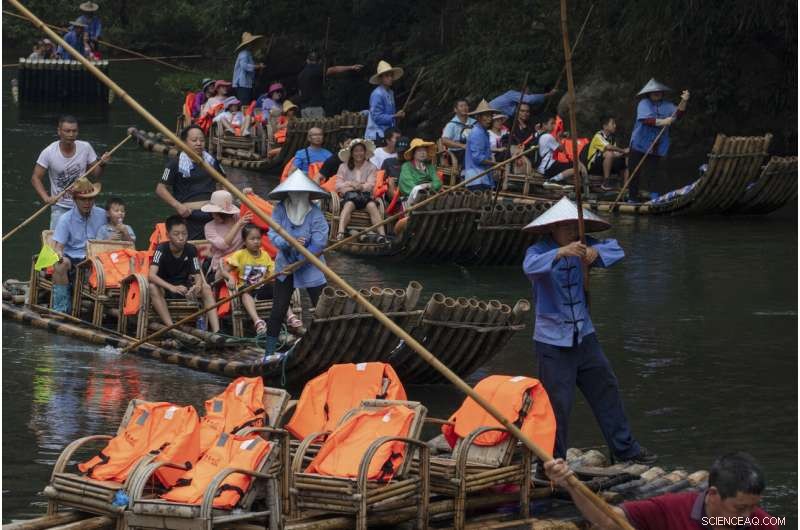
Tourists ride in bamboo rafts during a tour of the Nine Bends River in Wuyishan in eastern China's Fujian province on Thursday, 15 de agosto 2019. In August 2019, policymakers and scientists from China, the United States and other countries met in China to discuss the country's plans to create a unified park system with clear standards for limiting development and protecting ecosystems. (Foto AP / Ng Han Guan)
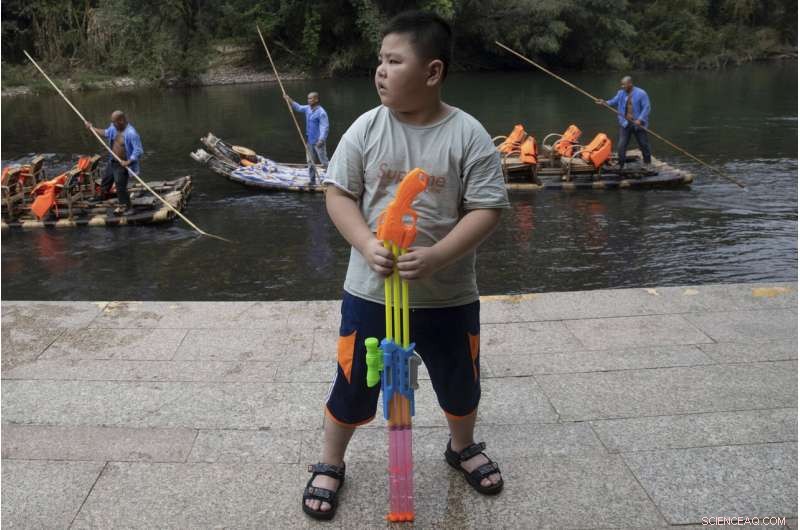
A boy holds a water rifle on the banks of the Nine Bends River as bamboo raft operators wait for tourists in Wuyishan in eastern China's Fujian province on Thursday, 15 de agosto 2019. Zhu Chunquan, the China representative of the International Union for the Conservation of Nature, a Switzerland-based scientific group, notes that the country's economy has boomed over the past 40 years. But priorities are now expanding to include conserving the country's key natural resources. "It's quite urgent, as soon as possible to identify the places, the ecosystems and other natural features" to protect, Zhu says. (Foto AP / Ng Han Guan)
Now Ouyang is drawing upon that work, combined with surveys of more than 1, 500 species of endangered and threatened plants and animals, to map priority areas for conservation and advise park planners. He is focusing on habitats of endangered species that live only in China.
"If we lose it here, se fue, " él dice.
The first parks to be formally incorporated into China's national park system will showcase the country's vast and varied landscapes and ecosystems—from the granite and sandstone cliffs of Wuyishan in eastern China to the lush forests of southwestern Sichuan province, home to giant pandas, to the boreal forests of northeastern China, where endangered Siberian tigers roam.
When it comes to ecology, few countries have more to lose, or to save, than China.
"A huge country like China literally determines the fate of species, " says Duke University's Pimm.
© 2019 The Associated Press. Reservados todos los derechos.